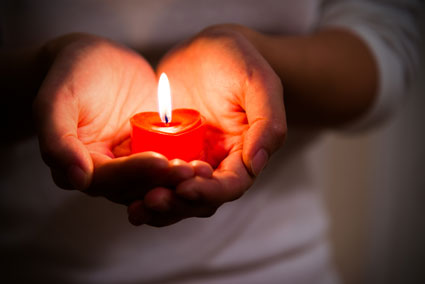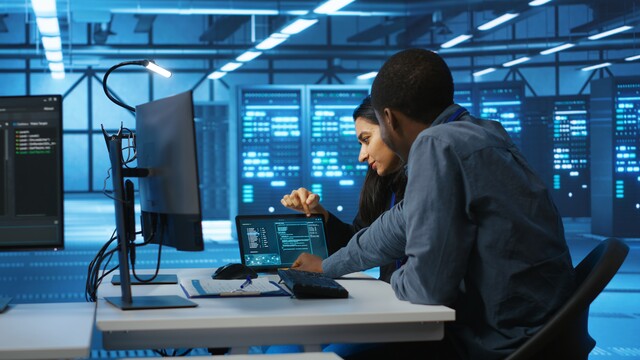Knowing Where to Talk
You should know enough about ham radio operation by now to surmise that you can't just turn on your radio and starting talking on any frequency that you want. While you will not find very specific "ragchew" frequencies listed in a guidebook, there are areas that you can transmit such casual conversations and areas on the radio spectrum to avoid.
Generally speaking, on HF frequencies below 30 MHz, it is safe to make a voice contact on the upper two-thirds of the band, while data modes such as Morse Code is on the lower-third. "DXing," or contests for distance contacts usually occur on the lower end of the band as well. This is true for two reasons. It is more difficult to make a long-distance contact since the signals are much weaker than short-distance contacts. For this reason, DX hams tend to congregate in the same isolated area of the band. Secondly, when the bands were originally divided into their various sub-bands, very few higher-class operators were found in the lower segments of each band.
Nets, which are generally very ordered meetings and places for specific types of conversation, tend to be far away from DX-ing on the band. So while DX-ing occurs at the lower end of the band, you will find most nets in the upper-third of the band.
On rare occasions, such as emergencies, the FCC can restrict certain frequencies for emergency traffic only. It is the responsibility of amateurs to keep clear and stay away from those frequencies during that time. The ARRL will send out bulletins about these emergency restrictions and announce them on the air and on their website.
On VHF and UHF bands, you can find ragchews in the sections of the bands devoted to repeaters, but you can almost always find casual contacts on the weaker signals portion of the band as well. As you are tuning the band, it will become apparent to you which repeaters are welcoming conversation and which are not. If you find a repeater that is conversation-friendly, you will have no problem at all at making contacts. To find one, you simply listen for someone saying something like this: "AC6V monitoring�:" AC6V is, of course, the call sign of a ham who is looking for a casual conversation. You would respond with a 1 by 2 call, as in "AC6V, this is KJ2B, this is KJ2B, over." You would repeat your call sign twice and you would use phonetics, not letters.
Casual conversations should contain short intervals of speech. If one person is speaking for more than four or five minutes, the repeater might time out. The time out function is used to prevent transmitters from overheating, and it is just polite practice from not hogging the airwaves and preventing other people from speaking.
Some repeaters are closed to the general public and you should always consult a directory before you begin using one. You can use a closed repeater, however, in the event of an emergency.
Knowing When to Talk
Just as it is important to know where to talk, it is important to know when it is proper to do so. During the day on a weekday is the best time to find or initiate a ragchew, but do keep in mind the difference in time zones if you are contacting someone over a great distance. During weekdays, hams are at their day jobs or they are travelling and are probably looking for contacts.
On weekends, however, there is an enormous amount of traffic on the air and much of it will be organized � DX-ing, Nets, and other various functions. The good news is that you will find many people on the air, but the bad news is that it is considered impolite to interrupt meetings (Nets) for making casual conversations.
If the bands seem far too full on the weekends, there are some strategies that you can employ to make your calling experiences more pleasant:
- Try a WARC band. The WARC bands are the 30m, 17m and 12m bands. They tend to be less crowded on the weekends, since the majority of DX-ing and Nets occur on the traditional bands.
- You can use a data mode, such as Morse Code.
- Use your receiver wisely. Adjust the filters to find those weaker signals.
- Just change the frequency. There is plenty of space on the air so just go exploring!
Identifying a Ragchewer
When you hear a conversation on the air, there are some signs that will alert you that it might be a conversation that would welcome your input. You should use your own judgment to determine how relaxed the tone appears. It is acceptable to interrupt, or "break in," a conversation. Most hams will welcome an added contact to the conversation, but the only way to ascertain this is to listen to the verbal cues you are receiving from the conversation.
There are a few signs that should alert you that a conversation would not welcome an additional contact. If there is an enormous amount of callers contained within the conversation, it is probably a contest � a DX contest. This is not for conversation purposes, it is simply a contest to see who can contact the furthest station. If you wish to join the contest, respond, but if you are looking for a ragchew, change your frequency.
Morse Code
There are preferred methods for communicating via Morse Code. Using headphones is a good start since you need to listen very carefully to the tones to ascertain the codes. You should make sure that the volume is varied from time to time as it is dangerous to your ears to listen to the same tones over and over again.
A filter that is 500 Hz wide is best to use with Morse Code. You do not need a very wide filter for Morse Code transmissions and this should be a good size for most instances. You can purchase these filters whether you have a new or used radio. Do not use a narrower filter than 500 Hz, as this can actually cause an unnatural sound and, thus, negate the positive effects of the filter's ability to prevent interference.
Emergency Organizations
Licensed hams are often called upon to assist in times of crisis and emergency. Hams have lent their voices and technological expertise for earthquakes, fires, natural disasters, and even for debris collection from the space shuttle Columbia accident.
After licensed hams have some radio experience, they may wish to participate in emcomm, which is a radio term for emergency communication. Emcomm is simply communication that tries to minimize the adverse effects of emergency situations.
Probably the largest emergency organization in the world of ham radio is the Amateur Radio Emergency Service (ARES), which is part of ARRL's Field Organization. Individual sections of the ARRL organize ARES, so the geographical reach of local ARES sections is based on population.
Hams with some radio experience can apply to volunteer positions within ARES in their local ARRL sections. Assistant Section Managers are needed to assist appointed Section Managers with tasks like working with local nets and collecting volunteer reports. Public Information Officers build good working relationships with local media and community leaders to publicize ham radio's public services. Official Observers help licensed hams stay within operating regulations to avoid FCC violations and also listen for unlicensed hams and other intrusions on amateur radio waves. Technical Specialists serve as consultants to hams and the ARRL on specific areas of specialty.
The ARRL offers training courses for licensed hams in how to handle emergencies. These courses are grant supported and are free to hams who successfully pass them. Interested hams can check the ARRL website at arrl.org for more information.
ARES handles emergencies that public safety and other civilian agencies respond to. Hams who wish to lend assistance to ARES need to register through their local ARRL section and join a local ARES team. ARES then handles training and simulation exercises for hams so that they can respond effectively in times of emergency.
Another emergency organization, the Radio Amateur Civil Emergency Service (RACES), is sponsored by the Federal Emergency Management Agency (FEMA) and responds when state or federal officials activate civil emergency response. To assist with RACES, a ham must be a member of RACES and also must be a member of and trained by a local civil defense preparedness group. It is recommended that a ham have some emergency experience, such as with ARES, before joining RACES. Joining RACES is through a state government's Auxiliary Communication Service.
A third organization is the Military Affiliate Radio Services (MARS). Each branch of the military has its own MARS program, and the overall organization is sponsored by the Department of Defense. MARS members can operate with special licenses on frequencies just outside the regular amateur frequencies. MARS volunteers handle connections between the military communications network and ham radio or between radios and the phone system, such as when deployed persons make contact with families at home.
Emergency Preparations
To be effective in times of emergency, a ham needs to prepare ahead of time. That way, when an emergency arises, a ham knows exactly what to do. It's wise to get to know team leaders and members of local emergency teams and also get to know the call signs of those who operate from Emergency Operating Centers (EOC). This will help knowing whom to contact and whom to listen for in times of emergency. Participating in regular exercises will help. Knowing the emergency net frequencies and names of leaders will also help so that in an emergency, a ham can zero in on the right band for emcomm.
It's also important to have the proper equipment and supplies ready to go as well. The ARRL can provide help in determining what a ham needs for the type of work she or he plans to do. In general, a ham should have a kit ready to go so that he or she can quickly get to the scene of an emergency. The kit should include versatile clothing, food that won't spoil and won't need preparation, water, lightweight radios and equipment, and a list of emcomm frequencies and telephone contacts. If a ham operates from home in an emergency, it's important to make sure that the radio can operate if electricity and the main antenna are both down.
Emergency Operations
When an emergency strikes, training in handling emergencies should guide a ham through the process. While all emergencies are different, this training helps cover all the important basics. In general, in cases of emergency, a ham should ensure that he or she, his or her family, and property are safe and secure. Otherwise, those needs must be attended to first. Then, a ham can begin monitoring emergency frequencies and follow instructions received from emergency officials over the frequency.
Hams can report emergencies, such as traffic accidents, using their radios if they have autopatch capabilities to connect with 911 over the radio. This involves breaking into a station's strong signal and gaining control of it to make the emergency report. Then, the rest is like making a regular 911 call.
Distress calls can be placed or received on ham radios. It's a great idea to store a frequency in a radio's memory where people most likely will be listening at any time. This way, any person can make a distress call if necessary. Making a distress call involves saying "Mayday," giving a call sign, stating location, stating the type of emergency, and stating the help needed. This can be repeated until someone responds. Similarly, upon hearing a distress call, a ham should write down all information given, respond to the call asking for more information, and contact 911 or appropriate agency for help. The agency may ask the ham to relay communications between the agency and the distressed party.
Other Services
The types of assistance that ham radio operators provide is not limited to emergencies. In fact, many hams participate in monitoring and reporting weather conditions. Under NOAA's SKYWARN program, weather nets on amateur radio frequencies report weather conditions directly to the National Weather Service.
Other public events, such as parades and sporting events, also need the help of amateur radio operators. These events usually coordinate with a local radio club or emergency group to help with their needs. Hams interested in volunteering should connect with the manager of the radio operations through the group assisting with the event.
Nets and Traffic
This chapter has referred to nets as a way that hams connect with a purpose of relaying emergency details or other information. A net is simply an on-air meeting of hams. These nets are scheduled for certain times and particular frequencies. Net activity is coordinated by a Net Control Station (NCS) that sets up, directs, and terminates the net. In nets that relay information back and forth, such as emergency cases, the NCS connects hams who have information to send with hams that can take the information. It is important that hams always check in with the NCS when ready to give or take messages.





















